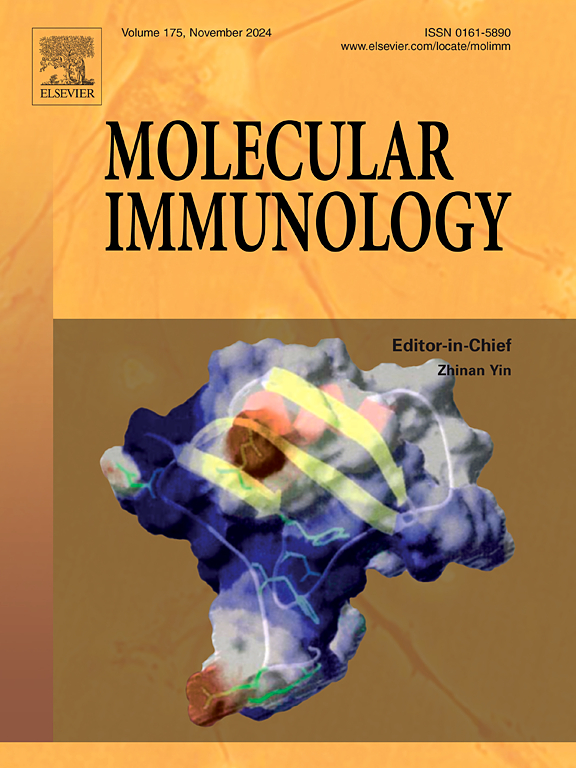Coxsackievirus-A10 induced RIPK3-driven necroptosis to promote the formation of inflammatory response and enhance virus production via being recognized by TLR3
IF 3.2
3区 医学
Q2 BIOCHEMISTRY & MOLECULAR BIOLOGY
引用次数: 0
Abstract
Neuronal death and neuroinflammation has been considered as the main contributors to the progression and deterioration of HFMD caused by CV-A10. Necroptosis is a lytic and inflammatory form of cell death that plays a crucial role in viral pathogenicity. Herein, our study showed that CV-A10-infected SH-SY5Y cells induced necroptosis via activating RIPK3-depedent pathway, but not requiring RIPK1, and meanwhile triggered the release of inflammatory cytokines. Moreover, RIPK3-mediated necroptosis was also involved in virus production, which did not require RIPK1 either. Finally, it was further verified that TLR3 drove RIPK3-mediated cell death by sensing CV-A10 RNA and activating RIPK3. Collectively, our study demonstrated that initiation of necroptosis in SH-SY5Y cells induced by CV-A10 accelerated the formation of inflammatory response and promoted virus replication through triggering a TLR3-initiated RIPK3-dependent pathway of necroptosis, which advanced the current understanding of necroptosis for the neuropathogenesis of CV-A10 infection.
柯萨奇病毒- a10通过被TLR3识别,诱导ripk3驱动的坏死下垂,促进炎症反应的形成,增强病毒的产生。
神经细胞死亡和神经炎症被认为是CV-A10引起手足口病进展和恶化的主要原因。坏死下垂是细胞死亡的一种溶解性和炎症性形式,在病毒致病性中起着至关重要的作用。本研究表明,cv - a10感染的SH-SY5Y细胞通过激活ripk3依赖通路诱导坏死下垂,但不需要RIPK1,同时触发炎症因子的释放。此外,ripk3介导的necroptosis也参与了病毒的产生,而病毒的产生也不需要RIPK1。最后,进一步验证了TLR3通过感知CV-A10 RNA并激活RIPK3驱动RIPK3介导的细胞死亡。综上所述,我们的研究表明,CV-A10诱导的SH-SY5Y细胞坏死性下垂的启动通过触发tlr3启动的ripk3依赖性坏死性下垂途径,加速了炎症反应的形成,促进了病毒复制,这进一步加深了目前对CV-A10感染的坏死性下垂神经发病机制的理解。
本文章由计算机程序翻译,如有差异,请以英文原文为准。
求助全文
约1分钟内获得全文
求助全文
来源期刊

Molecular immunology
医学-免疫学
CiteScore
6.90
自引率
2.80%
发文量
324
审稿时长
50 days
期刊介绍:
Molecular Immunology publishes original articles, reviews and commentaries on all areas of immunology, with a particular focus on description of cellular, biochemical or genetic mechanisms underlying immunological phenomena. Studies on all model organisms, from invertebrates to humans, are suitable. Examples include, but are not restricted to:
Infection, autoimmunity, transplantation, immunodeficiencies, inflammation and tumor immunology
Mechanisms of induction, regulation and termination of innate and adaptive immunity
Intercellular communication, cooperation and regulation
Intracellular mechanisms of immunity (endocytosis, protein trafficking, pathogen recognition, antigen presentation, etc)
Mechanisms of action of the cells and molecules of the immune system
Structural analysis
Development of the immune system
Comparative immunology and evolution of the immune system
"Omics" studies and bioinformatics
Vaccines, biotechnology and therapeutic manipulation of the immune system (therapeutic antibodies, cytokines, cellular therapies, etc)
Technical developments.
 求助内容:
求助内容: 应助结果提醒方式:
应助结果提醒方式:


